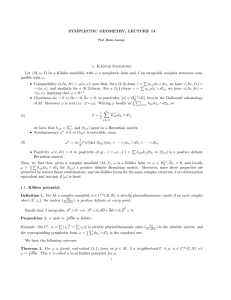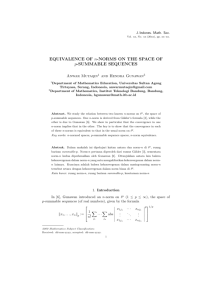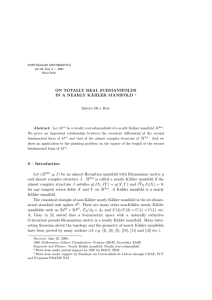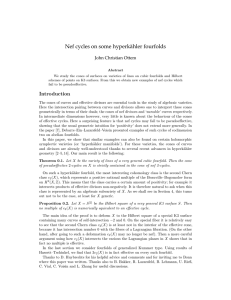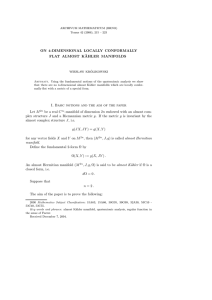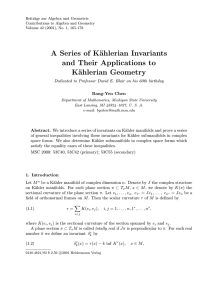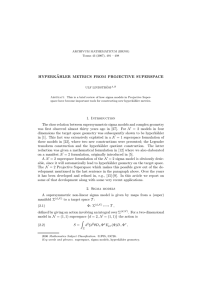NEARLY K ¨ AHLER AND NEARLY PARALLEL G -STRUCTURES
advertisement
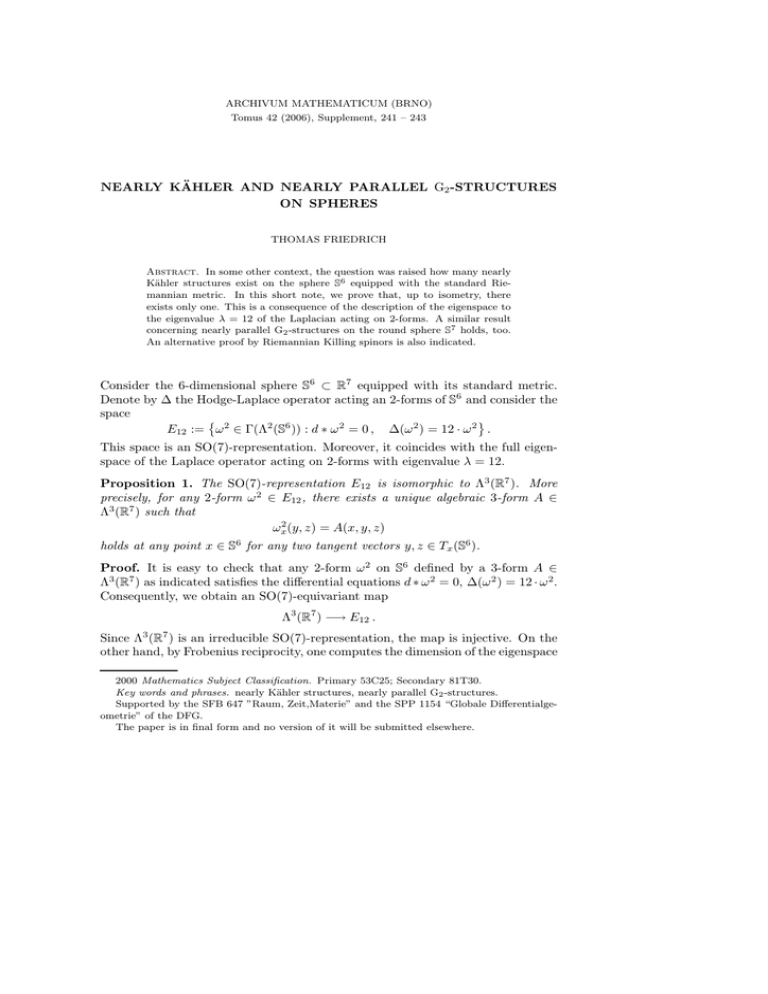
ARCHIVUM MATHEMATICUM (BRNO) Tomus 42 (2006), Supplement, 241 – 243 NEARLY KÄHLER AND NEARLY PARALLEL G2 -STRUCTURES ON SPHERES THOMAS FRIEDRICH Abstract. In some other context, the question was raised how many nearly Kähler structures exist on the sphere S6 equipped with the standard Riemannian metric. In this short note, we prove that, up to isometry, there exists only one. This is a consequence of the description of the eigenspace to the eigenvalue λ = 12 of the Laplacian acting on 2-forms. A similar result concerning nearly parallel G2 -structures on the round sphere S7 holds, too. An alternative proof by Riemannian Killing spinors is also indicated. Consider the 6-dimensional sphere S6 ⊂ R7 equipped with its standard metric. Denote by ∆ the Hodge-Laplace operator acting an 2-forms of S6 and consider the space E12 := ω 2 ∈ Γ(Λ2 (S6 )) : d ∗ ω 2 = 0 , ∆(ω 2 ) = 12 · ω 2 . This space is an SO(7)-representation. Moreover, it coincides with the full eigenspace of the Laplace operator acting on 2-forms with eigenvalue λ = 12. Proposition 1. The SO(7)-representation E12 is isomorphic to Λ3 (R7 ). More precisely, for any 2-form ω 2 ∈ E12 , there exists a unique algebraic 3-form A ∈ Λ3 (R7 ) such that ωx2 (y, z) = A(x, y, z) holds at any point x ∈ S6 for any two tangent vectors y, z ∈ Tx (S6 ). Proof. It is easy to check that any 2-form ω 2 on S6 defined by a 3-form A ∈ Λ3 (R7 ) as indicated satisfies the differential equations d ∗ ω 2 = 0, ∆(ω 2 ) = 12 · ω 2 . Consequently, we obtain an SO(7)-equivariant map Λ3 (R7 ) −→ E12 . Since Λ3 (R7 ) is an irreducible SO(7)-representation, the map is injective. On the other hand, by Frobenius reciprocity, one computes the dimension of the eigenspace 2000 Mathematics Subject Classification. Primary 53C25; Secondary 81T30. Key words and phrases. nearly Kähler structures, nearly parallel G2 -structures. Supported by the SFB 647 ”Raum, Zeit,Materie” and the SPP 1154 “Globale Differentialgeometrie” of the DFG. The paper is in final form and no version of it will be submitted elsewhere. 242 TH. FRIEDRICH of the Laplace operator on 2-forms to the eigenvalue λ = 12. Its dimension equals 35. We recall some basic properties of nearly Kähler manifolds in dimension six (see the paper [1]). Let (M 6 , J, g) be a nearly Kähler 6-manifold. Then it is an Einstein space with positive scalar curvature Scal > 0. The Kähler form Ω satisfies the differential equations 2 d ∗ Ω = 0 , ∆(Ω) = · Scal · Ω . 5 J In particular, the Kähler form Ω of any nearly Kähler structure (S6 , J, gcan) on the standard sphere S6 is a 2-form on S6 satisfying the equations d ∗ ΩJ = 0 and ∆(ΩJ ) = 12 · ΩJ . This observation yields the following result. Proposition 2. The Kähler form ΩJ of any nearly Kähler structure (S6 , J, gcan ) on the standard sphere is given by an algebraic 3-form A ∈ Λ3 (R7 ) via the formula ΩJx (y, z) = A(x, y, z) where x ∈ S6 is a point in the sphere and y, z ∈ Tx (S6 ) are tangent vectors. Since the Kähler form ΩJ is a non-degenerate 2-form at any point of the sphere S6 , the 3-form A ∈ Λ3 (R7 ) is a non-degenerate vector cross product in the sense of Gray (see [2], [4], [5]). For purely algebraic reasons it follows that two forms of that type are equivalent under the action of the group SO(7). Finally, we obtain the following Theorem 1. Let (S6 , J, gcan ) be a nearly Kähler structure on the standard 6sphere. Then the almost complex structure J is conjugated – under the action of the isometry group SO(7) – to the standard nearly Kähler structure of S6 . A similar argument applies in dimension seven, too. Theorem 2. Let (S7 , ω, gcan ) be a nearly parallel G2 -structure on the standard 7-sphere. Then it is conjugated – under the action of the isometry group SO(8) – to the standard nearly parallel G2 -structure of S7 . Remark. Nearly Kähler structures in dimension six and nearly parallel structures in dimension seven correspond to Riemannian Killing spinors. It is well-known that the isometry group of the spheres S6 and S7 acts transitively on the set of Killing spinor of length one. This observation yields a second proof of the latter Theorems (see [3] and [6]). Moreover, this argument proves that on a space different from the sphere the nearly Kähler structure (n = 6) is uniquely determined by the metric. Indeed, the space of Killing spinors is one-dimensional. References [1] Alexandrov, B., Friedrich, Th. and Schoemann, N., Almost hermitian 6-manifolds revisited, J. Geom. Phys. 53 (2005), 1–30. [2] Brown, R. B., Gray, A., Vector cross products, Comment. Math. Helv. 42 (1967), 222–236. NEARLY KÄHLER STRUCTURES ON S6 243 [3] Friedrich, Th., Kath, I., Moroianu, A. and Semmelmann, U., On nearly parallel G2 -structures, J. Geom. Phys. 23 (1997), 259–286. [4] Gray, A., Vector cross products on manifolds, Trans. Amer. Math. Soc. 141 (1969), 465–504. [5] Gray, A., Six-dimensional almost complex manifolds defined by means of three-fold vector cross products, Tohoku Math. J. II. Ser. 21 (1969), 614–620. [6] Grunewald, R., Six-dimensional Riemannian manifolds with a real Killing spinor, Ann. Global Anal. Geom. 8 (1990), 43–59. Institut für Mathematik Humboldt-Universität zu Berlin Sitz: WBC Adlershof D-10099 Berlin, Germany E-mail : friedric@mathematik.hu-berlin.de
